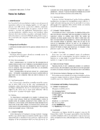issue contents
January 2000 issue

Cover illustration: Intensity difference signal recorded at a fixed photon energy as a function of the translation and rotation encoders of one of the two vertical focusing mirrors of the SB7 beamline at SuperACO, see Sirotti, Polack, Cantin, Sacchi, Delaunay, Meyer and Liberati, pages 5-11.
facility information
research papers
A new high-speed X-ray beam chopper using laser scanner technology has been developed and tested at the APS.
The performance of the SB7 beamline at SuperACO working in the energy range 150–1500 eV is reported, including resolution, flux and polarization tests. The performance of the double vertical mirror for circular polarization selection is also presented.
Experimental results on the performance limits of cryogenically cooled silicon monochromators at the APS are presented.
Two complementary rapid methods for the calibration of solid-state detectors are presented. The first uses a fluorescent glass standard and the second uses multiple diffraction lines from a material of known lattice spacing.
An experimental protocol promising immediate improvements in the temporal resolution achievable with synchrotron sources is described.
Self-propagating high-temperature synthesis provides an attractive practical method for producing advanced materials such as ceramics, composites and intermetallics. This kind of reaction has been investigated in situ using time-resolved X-ray diffraction, with an X-ray synchrotron beam coupled to simultaneous IR thermography to study structural transformations and thermal evolution.
Element mapping using an X-ray fluorescence imaging microscope at SPring-8 is reported.
short communications
Corrigendum. The scattering efficiencies of four test samples given in the original report were calculated incorrectly. Corrected values are provided; these are two to three orders of magnitude lower.
A workshop was held at Hamburg, Germany, to identify potential experiments in structural biology with a future X-ray free-electron laser. Applications for diffraction methods, spectroscopy, microscopy and holography of biological samples and their response to high doses were discussed.
international union of crystallography
Free 



 journal menu
journal menu
































